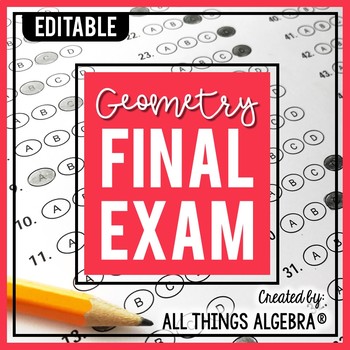Geometry Final Exam Prep

As the final exam for geometry approaches, it’s essential to review and reinforce your understanding of key concepts, theorems, and problem-solving strategies. The study of geometry involves the exploration of shapes, sizes, and positions of objects, as well as the relationships between them. This fundamental branch of mathematics not only underpins various fields like physics, engineering, and architecture but also enhances spatial reasoning, critical thinking, and problem-solving skills.
Core Concepts in Geometry
Points, Lines, and Planes: The foundation of geometry, these elements are crucial for understanding more complex concepts. A point is a location in space, a line is a set of points extending infinitely in two directions, and a plane is a flat surface that extends infinitely in all directions.
Angles and Measurements: Angles, formed by two rays sharing a common endpoint, are a key part of geometry. Understanding types of angles (acute, right, obtuse, straight) and how to measure them is vital.
Properties of Lines and Planes: Concepts such as parallel lines, perpendicular lines, and the properties of planes (like being flat and extending infinitely) are critical for more advanced study.
Triangles: A triangle is a polygon with three edges and three vertices. The study of triangles involves understanding types of triangles (equilateral, isosceles, scalene, right), triangle inequality, and triangle congruence theorems.
Circles: Circles, a set of points equidistant from a central point called the center, introduce concepts like radius, diameter, circumference, and arc length. Theorems related to circles, such as the Inscribed Angle Theorem and the properties of tangents, are also important.
Quadrilaterals and Polygons: Beyond triangles, the study of quadrilaterals (four-sided figures) and other polygons involves understanding their properties, such as symmetry, interior and exterior angles, and area calculations.
Theorems and Proofs
Pythagorean Theorem: One of the most famous theorems in geometry, it states that in a right-angled triangle, the square of the length of the hypotenuse (the side opposite the right angle) is equal to the sum of the squares of the lengths of the other two sides.
Congruence and Similarity: Understanding when two figures are congruent (identical in size and shape) or similar (same shape but not necessarily the same size) is key. Theorems like SAS (Side-Angle-Side), ASA (Angle-Side-Angle), and SSS (Side-Side-Side) for congruence, and AA (Angle-Angle) for similarity, are fundamental.
Geometry of Solids: This involves the study of three-dimensional figures, including understanding surface area, volume, and properties of specific solids like prisms, pyramids, spheres, and cones.
Problem-Solving Strategies
- Read Carefully: Understand what the problem is asking. Sometimes, the question might be about proving a theorem, calculating an area or volume, or determining properties of a figure.
- Draw Diagrams: Visual representation can help simplify complex problems. Drawing figures and labeling known information can lead to insights and solutions.
- Apply Theorems and Formulas: Knowing when to apply specific theorems or formulas is crucial. Practice helps in recognizing patterns and understanding which tools to use in different situations.
- Check and Verify: Especially in proofs and more complex problems, verifies each step logically follows from the previous one and that the conclusion correctly answers the question.
Preparation Tips
- Review Notes and Textbook: Go through your class notes, textbook, and any additional resources provided by your teacher. Summarize key points and concepts in your own words.
- Practice Problems: Practice is key to mastering geometry. Work through as many problems as you can find, starting with simpler ones and progressing to more complex ones.
- Use Online Resources: Websites, forums, and educational apps can provide additional practice problems, video lectures, and interactive tools to aid your learning.
- Form a Study Group: Sometimes, discussing concepts with classmates can clarify misunderstandings and provide new insights.
- Take Practice Exams: If possible, take practice exams or quizzes under timed conditions to simulate the actual exam experience and identify areas where you need more focus.
Conclusion
Preparing for a geometry final exam requires a comprehensive review of core concepts, theorems, and problem-solving strategies. By practicing regularly, using a variety of study materials, and staying focused, you can reinforce your understanding of geometry and perform well on your exam. Remember, geometry is not just about memorizing formulas and theorems; it’s about understanding the logic and beauty behind the spatial relationships and properties of objects, which can enrich your problem-solving abilities and appreciation for the world around you.
What are the key areas to focus on when studying for a geometry final exam?
+Key areas include points, lines, and planes; angles and measurements; properties of lines and planes; triangles; circles; quadrilaterals and polygons; theorems and proofs; and the geometry of solids. Understanding these concepts and being able to apply them to solve problems is crucial.
How can I improve my problem-solving skills in geometry?
+Improving problem-solving skills in geometry involves practicing a wide range of problems, from basic to complex. It’s also helpful to draw diagrams, apply theorems and formulas appropriately, and always verify your conclusions. Using different resources such as textbooks, online platforms, and study groups can provide varied practice and insights.
What are some tips for the day of the geometry final exam?
+On the day of the exam, make sure to get plenty of rest, eat a nutritious meal, and arrive early. Read each question carefully, manage your time effectively to complete all parts of the exam, and review your work if time allows. Stay calm and focused, and remember that you have prepared well for this moment.
